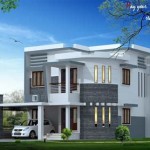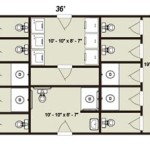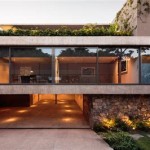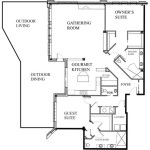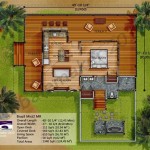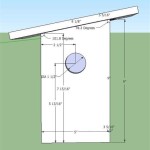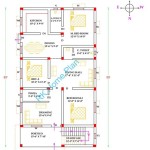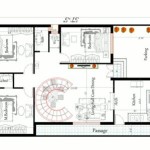Small Spanish House Floor Plans: Embracing Charm and Efficiency
Spanish house architecture, renowned for its distinctive aesthetic, evokes a sense of warmth, history, and connection to the natural landscape. While often associated with grand haciendas, the principles of Spanish design can be effectively translated into smaller, more manageable living spaces. Small Spanish house floor plans present a unique opportunity to maximize functionality while retaining the architectural character that defines the style. These plans often prioritize open layouts, integration of indoor and outdoor spaces, and utilization of natural light to create a comfortable and inviting home.
This article explores the key elements of small Spanish house floor plans, highlighting the design features that make them appealing and practical. It examines how to optimize space, incorporate traditional details, and adapt the style to meet modern living requirements. Understanding these concepts is crucial for anyone considering building or renovating a small Spanish-style home.
Key Elements of Small Spanish House Floor Plans
Several core architectural elements define the essence of Spanish house design and are crucial considerations for small floor plans. These elements contribute to the overall aesthetic and functionality of the space. Ignoring these key features can result in a design that, while technically small and with a similar footprint, lacks the authentic Spanish character desired.
One of the most important elements is the use of thick walls. Traditionally constructed from adobe or stucco, these walls provide excellent insulation, helping to regulate temperature and reduce energy consumption. In modern construction, similar effects can be achieved with well-insulated frame walls and stucco cladding. The thickness of the walls also creates deep-set windows, adding to the architectural depth and character. However, thick walls can impact the overall usable square footage inside a smaller home. Careful planning is necessary to minimize wasted space while retaining the aesthetic appeal of thick walls. This can be achieved by carefully considering the placement of windows and doors, and by utilizing the wall depth for built-in storage solutions.
Another defining feature is the inclusion of a courtyard, or patio. While a large courtyard might not be feasible in a very small house, even a modest outdoor space can significantly enhance the living experience. Courtyards provide a private outdoor retreat, allowing for natural light and ventilation to permeate the interior. They can also serve as an extension of the living space, perfect for dining, relaxing, or entertaining. The design of the courtyard should complement the overall architectural style, incorporating elements such as fountains, tilework, and lush landscaping. In smaller floor plans, a strategically placed patio can visually expand the living area, blurring the boundaries between indoors and out.
Finally, the roof design plays a significant role in the overall aesthetic. Spanish houses typically feature low-pitched, red-tiled roofs. This type of roof is not only visually appealing but also functional, providing excellent protection from the elements. In small house designs, the roof can be simplified to reduce construction costs and complexity. However, the red tile should be retained to maintain the authentic Spanish look. Consideration should also be given to the overhang of the roof, which can provide shade and protection from the sun. The overhang can also be designed to incorporate architectural details such as corbels or brackets, further enhancing the Spanish character of the house.
Optimizing Space in Small Spanish House Floor Plans
Maximizing usable space is paramount in small house design. Careful planning and strategic use of architectural elements can create a sense of spaciousness and functionality, even within a limited footprint. The challenge lies in balancing the need for living space with the desire to maintain the architectural integrity of the Spanish style.
Open floor plans are particularly well-suited for small Spanish houses. Combining the living room, dining area, and kitchen into a single open space creates a sense of flow and connectivity. This arrangement allows natural light to penetrate deeper into the interior, making the space feel brighter and more inviting. To define distinct areas within the open floor plan, consider using architectural elements such as archways, columns, or changes in floor level. These elements can visually separate the different zones without completely closing them off. Furniture arrangement can also play a key role in defining spaces, with strategically placed sofas, tables, and rugs effectively delineating the living, dining, and kitchen areas.
Vertical space should also be carefully considered. High ceilings can create a sense of grandeur and spaciousness, even in a small house. Incorporating features such as exposed beams or vaulted ceilings can further enhance the visual impact. Lofts can be used to create additional living space, such as a bedroom or office, without adding to the overall footprint of the house. Storage solutions should be integrated vertically as well, with tall cabinets and shelves maximizing the use of wall space. By utilizing vertical space effectively, small Spanish houses can provide ample storage and living space without feeling cramped or cluttered.
Built-in storage is another essential strategy for optimizing space. Custom-designed cabinets, shelves, and drawers can be tailored to fit the specific needs of the homeowner, maximizing storage capacity while minimizing wasted space. Built-in seating, such as window seats or banquettes, can also serve as storage compartments, providing a dual function and saving valuable floor space. Alcoves and niches can be used to create unique storage solutions, adding architectural interest to the space while providing a place to store books, artwork, or other personal items. Careful planning and attention to detail are crucial for creating effective built-in storage solutions that enhance the functionality and aesthetic appeal of the house.
Adapting Spanish Style to Modern Living
While maintaining the traditional charm of Spanish architecture is important, it is also essential to adapt the style to meet the demands of modern living. Integrating contemporary features and technologies can enhance the comfort, convenience, and energy efficiency of a small Spanish house without compromising its architectural integrity.
Modern kitchens and bathrooms should be seamlessly integrated into the overall design. While retaining the traditional elements of Spanish style, such as tilework and natural materials, these spaces should also incorporate modern appliances, fixtures, and technologies. For example, a modern kitchen might feature stainless steel appliances, granite countertops, and energy-efficient lighting, while still incorporating traditional Spanish tile backsplashes and wooden cabinetry. Bathrooms can be updated with modern showers, toilets, and vanities, while retaining the traditional Spanish tile flooring and wrought iron accents. The key is to strike a balance between traditional and modern elements, creating spaces that are both functional and aesthetically pleasing.
Energy efficiency is another crucial consideration. Small houses are inherently more energy-efficient than larger houses, but further improvements can be made by incorporating energy-efficient windows, insulation, and appliances. Solar panels can be integrated into the roof design, providing a renewable source of energy and reducing reliance on fossil fuels. Water-saving fixtures, such as low-flow toilets and showerheads, can also help to conserve water. By incorporating these energy-efficient features, small Spanish houses can be both environmentally friendly and cost-effective to operate.
Finally, technology should be seamlessly integrated into the design. Smart home systems can be used to control lighting, temperature, security, and entertainment, providing added convenience and security. Wireless internet access should be available throughout the house, allowing residents to stay connected and productive. Home theaters, media centers, and gaming rooms can be incorporated into the design, providing entertainment options for the whole family. The key is to integrate these technologies in a way that is both functional and aesthetically pleasing, without detracting from the overall Spanish character of the house. Concealed wiring, hidden speakers, and discreetly placed control panels can help to minimize the visual impact of technology.

Small Spanish Contemporary House Plan 61custom Modern Plans Style Homes

Bungalow House Plans Spanish Style Homes Craftsman

Small Spanish Contemporary House Plan 61custom Modern Plans Style Homes Mediterranean

1927 Radford Zamora Spanish Eclectic Style Small House Design Inspiration Vintage American Architure

Small Spanish Contemporary House Plan 61custom Modern Plans

Spanish House Plans Hacienda And Villa Style

Bungalow House Plans Colonial Mediterranean

Spanish House Plans Monster

Spanish Revival Style Home 1926 Universal Plan Service No 543 House Plans Portland Homes

Spanish Style Plans 1900 To1935 Vintage House Homes

